Radio-controlled mine sweepers of the project Minenräumwagen Sonderkraftfahrzeug 300 (Germany)
In 1939, a proposal appeared to develop a special remote-controlled vehicle designed to solve some combat missions. The light tracked vehicle of the new model should have been able to trawl minefields. In addition, it was proposed to make her a carrier of special charges of explosive. With the help of the latter, it was planned to destroy protected enemy firing points. After some disputes and discussions, it was decided to simultaneously develop two projects: the minesweeper and the transporter.
The creation of two new projects was entrusted to Borgward, which had some experience in developing armored vehicles of various types. In accordance with the existing equipment nomenclature, the project received the symbol Minenräumwagen Sd.Kfz.300 - “Special vehicle, demining machine model 300”. In addition, the specialists of the company-developer of the project was assigned a working designation B I.

Borgward BI minesweeper with skating rink. Photo by Chamberlain P., Doyle H. "Complete German Reference tanks and self-propelled guns of World War II "
The remote-controlled minesweeper Borgward BI had to make passes in minefields, working on commands from the operator’s console. There were also specific requirements regarding machine survivability. Despite a certain risk of blasting on an uncultivated mine, it was decided not to equip the minesweeper with powerful armor. On the contrary, it was proposed to make it as simple and cheap as possible, which made it possible to save on production and dispense with unnecessary expenses in case of loss of equipment.
For the minesweeper Sd.Kfz.300, a housing of relatively simple construction was developed. He had vertical sides, and also received a sloping frontal and stern sheet. On top of the internal units were closed with a lid. In order to save, it was decided to equip the BI machine with only one armor plate. The frontal part of the hull should have been made of armor 12 mm thick. It was proposed to make other elements of the hull from structural steel, which could not provide any protection against real threats and only covered the internal units from certain external influences.
The body of a simple design gave the car a distinctive appearance. Minesweeper was a box of irregular shape on a crawler. On the outer surfaces of the case there was a minimum number of protruding elements. In particular, the muffler and the exhaust pipe of the engine were taken to the stern of the left side.
In front of the hull, right behind the armor plate, it was proposed to install transmission units, as well as large and heavy radio control equipment. Feed was given to the installation of the engine. Free hull volumes were allocated for gas tanks and other units for various purposes.
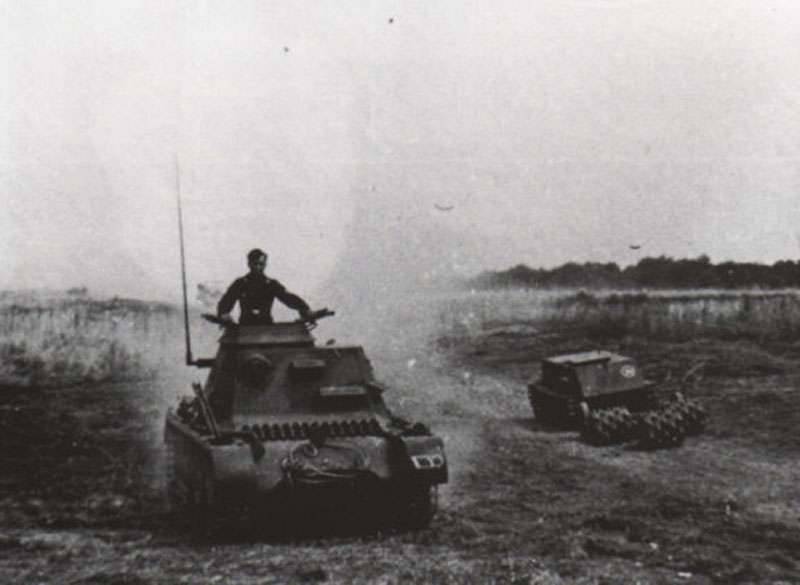
Trawling during testing. On the left is the control machine. Photo Aviarmor.net
The carburetor engine Borgward 4M with the power of just 29 hp should be installed in the case. Such a power plant allowed the car to reach a speed not higher than 3-5 km / h, however, this was enough to solve the main tasks. With the help of a mechanical transmission, the engine torque was transmitted to the front-wheel drive wheels.
Chassis, like the whole machine as a whole, had a simple design. Minesweeper Borgward BI received three road wheels with an individual suspension on each side. In front of the hull were placed the driving wheels, in the stern - guides. A small caterpillar with a single crest was used. Due to the large diameter of the rollers, the track did not need additional support rollers.
Mine clearance was proposed using a roller trawl of a simple construction. Its main element was a frame, in the back of which mounts were provided for installation on the minesweeper. In the central part of the frame two rollers-wheels were placed to maintain the device in the correct position, and three rollers for trawling were fixed in the front. The latter was a construction of several metal disks of complex shape, connected in one block. For trawling a broad lane it was proposed to use three rollers. At the same time, the central one was moved forward relatively lateral, thus providing partial overlapping of three lanes from the rollers. According to reports, the radio-controlled car could drag the trawl behind him, and before the combat work it should be mounted on the front towing device.
The total length of the minesweeper Minenräumwagen Sd.Kfz.300 of the first version was 1,85 m, width 800 mm, height - 650 mm. Combat weight did not exceed 1500 kg. Despite the relatively high power density (more than 19 hp per ton), the BI machine could only accelerate to 5 km / h. The supply of fuel was enough to overcome the 18 km and work for more than three hours.
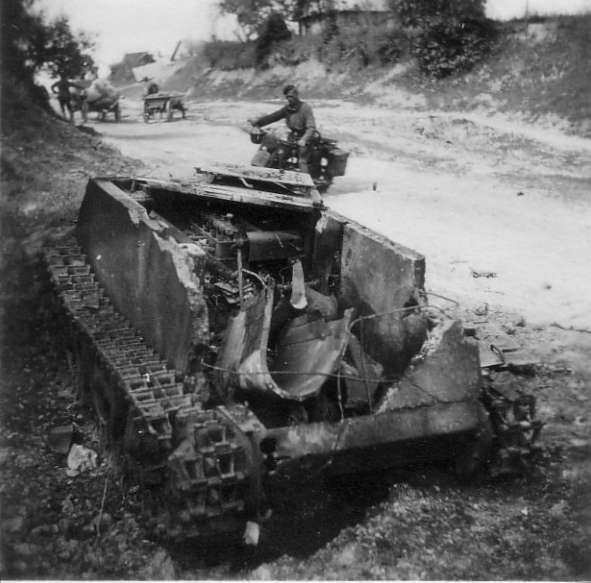
Destroyed BI machine with reinforced concrete hull. Photo Aviarmor.net
The minesweeper of the new type was equipped with a radio control system from a remote operator’s console. To accommodate the remote, it was proposed to use a special machine that could protect the operator from various threats. The Kleine Panzerbefehlswagen (Kl.Bef.Wg.) or Sd.Kfz.265, based on a light tank Pz.Kpfw.I., was taken as the basis for a mobile command and control station.
The command vehicle differed from the base model tank by the absence of a turret, instead of which a high wheelhouse was installed. In the heading of the cabin there was an installation for a machine gun, which was the only own armament of the machine. For use in the Minenräumwagen Sd.Kfz.300 project, the command vehicle received radio control equipment, a console and other systems necessary to monitor the work of the minesweeper. When installing a new equipment commander machine should not be subjected to serious modifications. All the necessary devices were placed inside the existing housing.
The development of the Sonderkraftfahrzeug 300 project in the BI version was completed before the end of 1939, after which the documentation was transferred to production. In the same year, the first prototype of a radio-controlled minesweeper was assembled, and the serial machine Kl.Bef.Wg. was converted into a mobile control point. In accordance with the order of the military, the production of minesweepers was continued. Until May 1940, the company Borgward has collected fifty of these machines of the first modification.
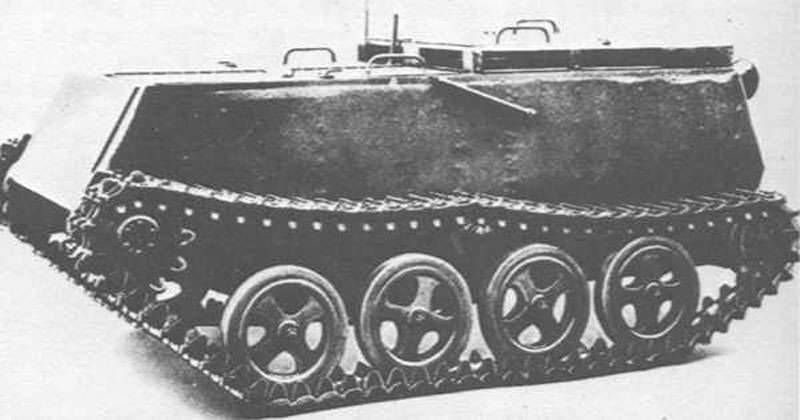
Upgraded version B II. Photo Waralbum.ru
The serial production of BI minesweepers is associated with some questions that are not answered yet. According to reports, to reduce the cost of production, it was decided to equip such machines with a frontal armor plate and other hull parts made of ordinary steel. At the same time there are photographs of the destroyed minesweepers, which clearly show that these machines received the upper part of the body from reinforced concrete. The exact origin of this version of the minesweeper is not known for certain. Nevertheless, the available photos clearly show that the manufacturers of the equipment tried in every possible way to reduce the cost of it and save the scarce metal.
At the end of 1939 and the beginning of 1940, several experienced minesweepers of the first version passed the necessary tests. These machines had the opportunity to make a passage about 1 m wide, because of which, to create a full-fledged track for the equipment, it was necessary to make two trips to the minefield, or to use two minesweepers simultaneously. The strength of the used rollers trawling enough for the disposal of anti-personnel mines.
Minesweeper Minenräumwagen Sd.Kfz.300 of the first model did not quite suit the customer. According to the results of tests in April 1940, the order appeared to develop a new modification of this car. It was necessary to rework in some way the existing design and improve a number of characteristics. In July, it was planned to launch the mass production of a modernized minesweeper and build at least a hundred of these machines.
The second version of the radio-controlled minesweeper received the factory designation B II. The new machine was supposed to retain the main features of its predecessor, but significant changes were made to its design. In particular, the power plant was modified, the chassis was modified, and the hull received an updated design.
According to the experience of testing the first minesweeper, it was decided to change the design of the hull. The most noticeable change was the appearance of the grille on the stern sheet, which was supposed to improve engine cooling. Also, the car version B II received a more powerful six-cylinder engine type Borgward B6, capable of producing up to 49 hp. An additional pair of track rollers appeared in the undercarriage, and the rollers themselves now had a much smaller diameter. In connection with the reduction of the rollers, the chassis had to be supplemented with a pair of supporting rollers.
The radio control system developed for the first version of the machine was used in the new project. The new minesweeper had to be controlled from a remote console mounted on the commander machine Kl.Bef.Wg. Special equipment in the form of a katkovy trawl push action also remained unchanged. Like the first version of the Minenräumwagen Sd.Kfz.300, the new B II had to make a passage in the minefield with the construction of three rollers.
The upgraded minesweeper retained the dimensions of its predecessor, but became heavier - its combat weight reached 2300 kg. The increase in engine power was completely offset by weight gain, which is why the maximum speed of the Borgward B II remained at the same level - up to 5 km / h. Simultaneously, the power reserve increased to 30 km.
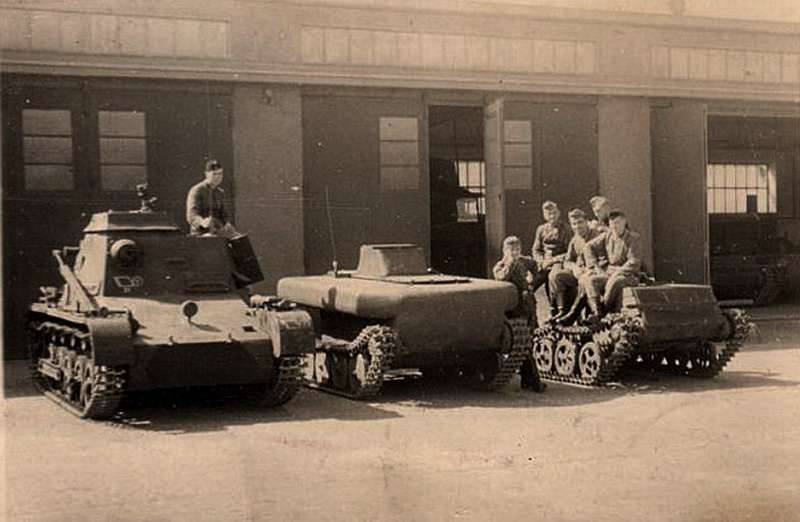
Different machines of the project Sd.Kfz.300. From left to right: Kl.Bef.Wg. command vehicle, Ente amphibian and minesweeper Borgward B II. Photo Shushpanzer-ru.livejournal.com
In the summer of 1940, the upgraded version of the radio-controlled machine was put to the test. Apparently, during the inspections, this product could not show the required characteristics, which is why the customer began to doubt the prospects of the entire project. Moreover, following the results of the tests, it was decided to abandon the start of the serial construction of the Sd.Kfz.300 machines of the second option. The assembly of the party of hundreds of minesweepers, the start of which was scheduled for August, was canceled a few weeks before the start.
The latest development in the Sonderkraftfahrzeug 300 project was the experimental floating machine Ente ("Duck"). Based on the design of the minesweeper B II, it was proposed to build a machine with the possibility of crossing water obstacles by swimming. To do this, we had to seriously rework the existing case, as well as make adjustments to the composition of the transmission in order to use the new propulsion unit for moving through water.
The main external difference of the “Duck” from the base minesweeper was the modified sealed hull, which included floats to ensure the required buoyancy. The hull was a little taller, its frontal part was now set with a slope forward. In addition, over the sides and the stern appeared U-shaped float filled with air. Due to all these improvements, the car was supposed to have to steadily float.
Also on the roof of the case appeared a small metal cabin with a beveled front sheet. It probably housed the engine intake pipe. Raising the pipe cut above the roof, the designers intended to exclude the ingress of water with subsequent unpleasant consequences for the engine.
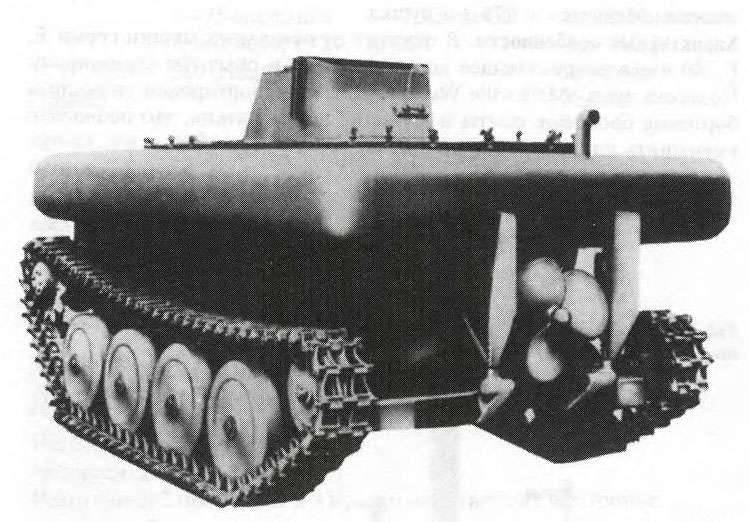
Experimental car Ente, rear view. Photo of Chamberlain P., Doyle H. "Complete reference book of German tanks and self-propelled guns of the Second World War"
Especially for the Ente car was developed a new propulsion. A propeller with three blades appeared on the stern sheet. Next to it were installed two steering wheels for maneuvering. The propeller shaft was connected to the units of the updated transmission and was supposed to provide the movement of the machine through the water. Management was proposed to carry out due to the deviation of the rudders.
With all the modifications and innovations, the Ente experimental machine was as unified as possible with the minesweeper Borgward B II. In particular, similar control systems and the same machine with an operator’s console were used. At the same time, the floating version of radio-controlled equipment lost the ability to tow a mine trawl, since it was intended for other tasks.
According to various sources, no more than two prototypes of the “Duck” model were made. For some time they were tested on the ground and on the water, after which the work was completed and stopped. The floating machine was not put into the series and was not offered for use in the army. It was created solely for the purpose of conducting experiments and developing some technical solutions.
During 1939-40, several dozen Sd.Kfz.300 machines were built by Borgward. The first version of the BI minesweeper was the most widespread - the customer received about fifty such machines. Later several prototypes of B II and Ente were released. According to various estimates, the total number of machines in the family does not exceed 53-55 units, including prototypes of all models.
According to most sources, the Minenräumwagen Sd.Kfz.300 project technique did not go beyond the limits of the polygons and was used only in tests. At the same time, however, there are photographs of the destroyed minesweepers, which, for one reason or another, can be considered evidence of the combat use of such equipment. In particular, these photos confirm the release of minesweepers with cheap concrete hulls. Nevertheless, the details of this version of the project and the possible combat use of minesweepers, as well as information about their destruction is missing.
The Minenräumwagen Sonderkraftfahrzeug 300 program allowed us to test the possibility of building and practical use of special equipment with remote control. The developments created in the course of this project, apparently, could not occupy an appropriate place in the troops. Nevertheless, the project confirmed the possibility of full use of new ideas. The result was the launch of several new projects of remotely controlled equipment for various purposes. Some of these samples later even reached mass production and operation in the army.
Based on:
http://achtungpanzer.com/
http://aviarmor.net/
http://kfzderwehrmacht.de/
http://shushpanzer-ru.livejournal.com/
Chamberlain P., Doyle H. Complete reference book of German tanks and self-propelled guns of the Second World War. - M .: AST: Astrel, 2008.
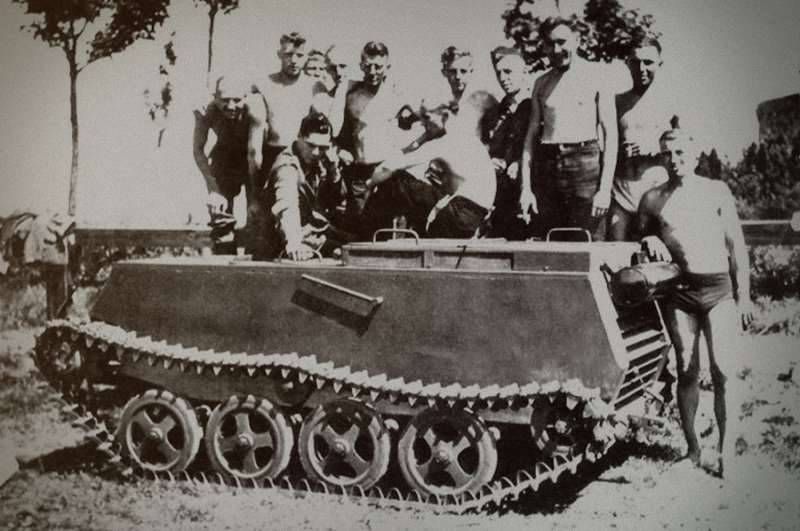
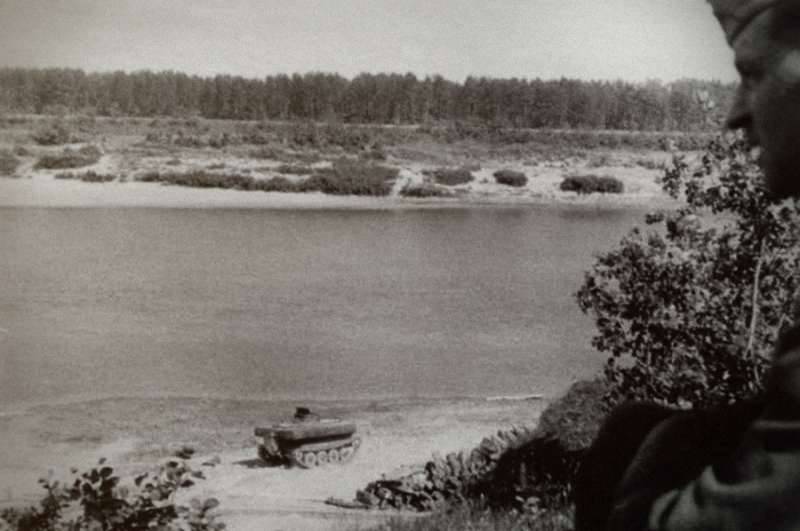
Information